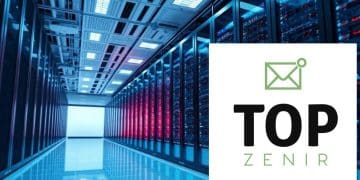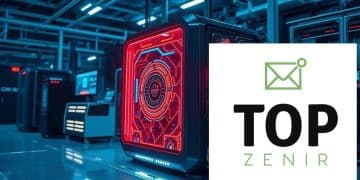Businesses embrace hybrid computing models for growth

Businesses embrace hybrid computing models to enhance flexibility, cost efficiency, and data security while addressing challenges like integration and staff training, positioning themselves for future technological advancements.
Businesses embrace hybrid computing models as a way to adapt and thrive in a rapidly changing market. This approach not only enhances flexibility but also helps companies leverage both cloud and on-premises resources effectively. Curious about how this can transform your operations?
Understanding hybrid computing models
Understanding hybrid computing models is essential for businesses seeking flexibility and efficiency in their operations. These models blend on-premises infrastructure with cloud services, enabling companies to maximize their resources.
What Are Hybrid Computing Models?
Hybrid computing models combine private cloud, public cloud, and on-premises solutions. This integration allows businesses to choose where to run applications and store data based on their specific needs.
Key Advantages of Hybrid Models
By adopting hybrid computing, firms can enjoy numerous benefits. Here are some key advantages:
- Increased flexibility in resource allocation.
- Cost savings through optimized cloud usage.
- Enhanced disaster recovery options.
- Improved scalability for fluctuating demands.
Moreover, hybrid models enable businesses to maintain control over sensitive data while benefiting from the scalability of cloud solutions. This balanced approach allows for a more agile response to market changes.
Challenges in Adoption
Despite the many advantages, businesses may face several challenges when adopting hybrid computing models. Data security and compliance can become complex when navigating multiple environments. Additionally, organizations need to ensure that their staff is adequately trained to manage this hybrid infrastructure effectively.
As companies integrate these models, it becomes crucial to develop a robust strategy for managing both cloud and on-premises resources. Ongoing support and monitoring are necessary to maintain optimal performance.
In a rapidly evolving tech landscape, understanding hybrid computing models ensures that organizations can leverage the best of both worlds. By combining flexibility with security, businesses can stay competitive and responsive.
Key benefits for businesses

Understanding the key benefits for businesses adopting hybrid computing models can guide organizations towards more efficient operations. These advantages are transforming how companies operate in today’s digital age.
Enhanced Flexibility
One of the primary advantages is enhanced flexibility. Organizations can easily adapt their resources based on fluctuating workloads. This ability to scale up or down ensures that businesses only pay for what they use, significantly reducing costs.
Cost Efficiency
Hybrid computing models also promote cost efficiency, allowing businesses to optimize their IT spending. With the mix of private and public clouds, they can choose the most cost-effective environment for their needs, balancing performance and expenditure.
- Lower operational costs through resource optimization.
- Reduced hardware investments with cloud solutions.
- Flexible payment models for cloud services.
- Minimized downtime and business interruptions.
Another compelling benefit is improved disaster recovery. By leveraging multiple environments, businesses can enhance their data backup processes. If one system faces an issue, another can quickly take over, ensuring business continuity.
Increased Innovation
With hybrid models, companies can adopt new technologies and experiment without overcommitting resources. This ongoing capacity for innovation helps firms stay competitive in their respective markets, allowing them to respond to evolving consumer demands.
Ultimately, the key benefits for businesses embracing hybrid computing models create an agile environment where change is managed effectively and resources are utilized efficiently. This adaptability is vital for long-term success.
How to implement hybrid computing successfully
Implementing hybrid computing successfully requires a strategic approach. Businesses must assess their current infrastructure and identify the best combination of on-premises and cloud solutions.
Assess Your Needs
Start by evaluating your organization’s specific needs. Determine which applications are best suited for the cloud and which should remain on-premises. This assessment helps create a tailored hybrid model that meets your operational requirements.
Choose the Right Tools
Select the right tools and platforms for managing your hybrid environment. Different cloud service providers offer various services and features.
- Look for providers with strong security measures.
- Ensure they offer seamless integration with existing systems.
- Evaluate the scalability options available.
- Consider customer support and service level agreements (SLAs).
Once you have selected your tools, focus on data management processes. Establish clear protocols for moving data between environments. Proper data governance ensures compliance and security, which are crucial in hybrid setups.
Train Your Team
Training your team is vital for successful implementation. Make sure that staff members understand how to work within a hybrid computing model. Provide training sessions on new technologies and encourage continuous learning.
In addition, fostering a culture that embraces technology helps smooth the transition to hybrid computing. Encourage teams to share best practices and learn from one another as they adapt to new workflows.
Regularly review and adjust your hybrid strategy based on performance metrics and feedback. This ongoing process ensures that your hybrid computing model remains effective and continues to meet business needs.
Challenges in hybrid computing adoption
Adopting hybrid computing comes with its share of challenges. Companies must be aware of potential obstacles to ensure a smooth transition and effective implementation.
Data Security Concerns
One major challenge is ensuring data security. With a hybrid model, sensitive data moves between on-premises systems and the cloud. This can create vulnerabilities if not managed correctly. Businesses need to implement strong security protocols and keep data in compliance with regulations.
Integration Issues
Another obstacle involves integration issues. Merging existing IT systems with new cloud solutions can be complex. Companies must ensure that all systems work seamlessly together. This requires careful planning and, sometimes, significant investment in new technologies.
- Assess compatibility of existing systems.
- Choose tools that allow for easy integration.
- Test integrations thoroughly before full implementation.
Additionally, lack of standardization can lead to confusion among teams. Clearly defined processes and guidelines help alleviate this issue and ensure consistency.
Cost Management
Cost management is a critical factor as well. While hybrid models can lead to savings, they can also incur unexpected costs. Companies must track expenses closely and anticipate the needs for future scaling. Managing budgets efficiently is crucial to avoid overspending.
With all these challenges, proper training and support for staff become essential. Employees need to be well-prepared to navigate this hybrid environment. Training helps to minimize operational disruptions and fosters overall productivity.
By focusing on these challenges, companies can develop strategies to overcome them, ensuring successful adoption of hybrid computing.
Future trends in hybrid computing models
The future of hybrid computing models is bright and full of potential. As technology evolves, businesses will adopt new trends to enhance their operations and stay competitive in the market.
Increased Adoption of AI and Automation
One significant trend is the increased use of artificial intelligence (AI) and automation within hybrid models. This technology will allow for better data analysis and decision-making. Businesses will leverage AI tools to optimize resource allocation, enhance security, and streamline workflows.
Enhanced Security Measures
As cloud services grow, security will become even more critical. Future hybrid computing systems will likely integrate advanced security features. Enhanced encryption, multi-factor authentication, and continuous monitoring will help protect sensitive data.
- Adoption of zero-trust security models.
- Increased focus on compliance tracking.
- Integrating automated security protocols.
- Real-time threat detection and response.
These enhancements will provide businesses with more robust security options while maintaining flexibility in operations. Moreover, organizations will need to stay updated on regulatory changes that impact their cloud strategies.
Sustainability Initiatives
Sustainability will also be a driving force in the adoption of hybrid computing models. Companies are increasingly focused on minimizing their carbon footprint. By leveraging cloud solutions, organizations can reduce the energy needed for on-premises hardware and promote efficient energy use.
Tech providers will aim to develop greener data centers that utilize renewable energy sources, contributing to sustainability efforts. This shift will appeal to environmentally conscious consumers and investors alike.
As these future trends emerge, businesses must adapt to stay relevant. The successful integration of new technologies and practices will define the trajectory of hybrid computing models in the coming years.
In conclusion, embracing hybrid computing models is essential for businesses looking to thrive in a fast-paced digital world. These models offer flexibility, cost efficiency, and opportunities for innovation while addressing challenges like data security and integration. Companies must stay informed about future trends such as AI advancements and sustainability initiatives. By strategically adopting hybrid computing, organizations can optimize resources and remain competitive in the evolving landscape.
FAQ – Frequently Asked Questions about Hybrid Computing Models
What are the main benefits of hybrid computing?
Hybrid computing offers flexibility, cost efficiency, and improved data security, helping businesses adapt to changing needs.
How can I ensure data security in a hybrid computing model?
Implement strong security protocols, use encryption, and adopt a zero-trust security model to protect sensitive information.
What challenges can arise during the adoption of hybrid computing?
Common challenges include data integration issues, managing costs effectively, and ensuring staff are well-trained.
What future trends should businesses expect in hybrid computing?
Businesses should anticipate increased use of AI, enhanced security measures, and a focus on sustainability and energy efficiency.





